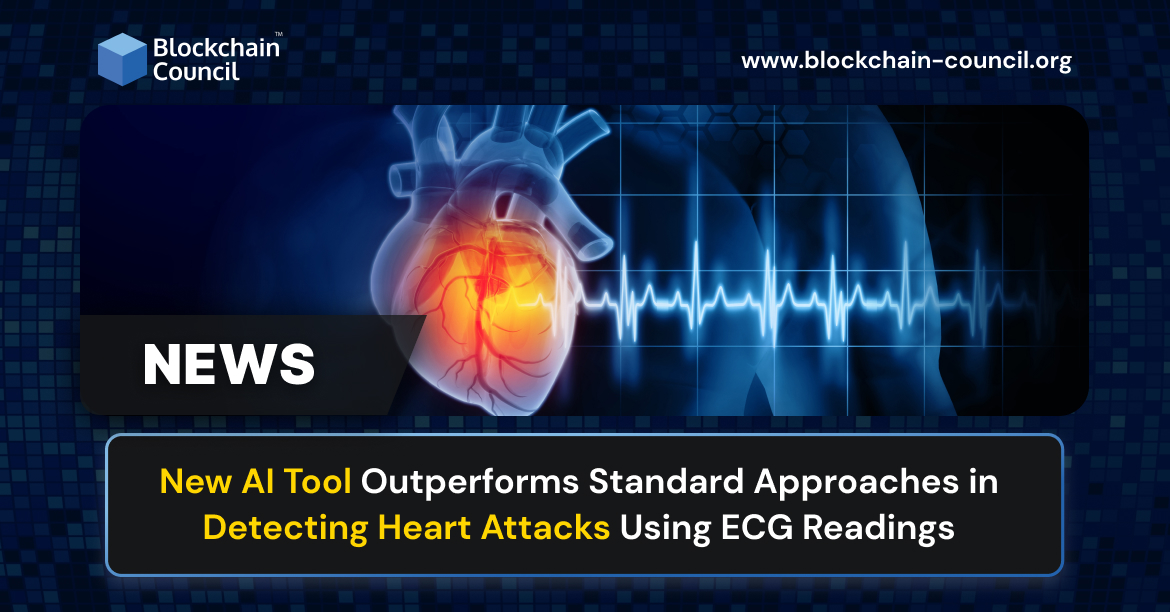
- Blockchain Council
- July 03, 2023
Researchers at the University of Pittsburgh Medical Center (UPMC) have made a groundbreaking discovery in the field of cardiology. They have developed a machine learning (ML) tool that outperforms standard approaches in detecting heart attacks using electrocardiogram (ECG) readings. This revolutionary AI tool has the potential to transform the way heart attacks are diagnosed and classified, leading to faster and more accurate treatment for patients.
When a patient arrives at the hospital with chest pain, determining whether they are experiencing a heart attack is the first crucial step. However, in cases where the ECG readings are unclear, it can take up to 24 hours to complete additional tests, causing significant delays in providing appropriate care. Lead author Salah Al-Zaiti, Ph.D., RN, associate professor in the Pitt School of Nursing and of emergency medicine and cardiology in the School of Medicine, explains, “Our model helps address this major challenge by improving risk assessment so that patients can get appropriate care without delay.”
The study, recently published in Nature Medicine, highlights the importance of identifying distinct patterns in the peaks and valleys of ECG readings to recognize a heart attack. However, up to two-thirds of heart attacks do not exhibit these patterns, making their detection more challenging. This is particularly problematic for patients with severe heart attacks caused by total blockages of a coronary artery, known as ST-elevation myocardial infarction (STEMI). Failure to identify clues in the ECG can lead to life-threatening complications for these patients.
Also read: Exploring the Contribution of Humans.ai in the AI World
The new ML tool developed by the researchers focuses on detecting subtle patterns in the ECG that may be clinically relevant but are often missed by clinicians. Additionally, the tool classifies patients into low, intermediate, or high risk of heart attack, providing a comprehensive assessment of each patient’s condition.
To develop and validate the model, ECG data from 4,026 patients with chest pain at three hospitals in Pittsburgh were used. The tool was then tested using data from an additional 3,287 patients from a separate health system. The researchers compared the performance of their model to three gold standards for evaluating cardiac events: experienced clinician interpretation of ECG, commercial ECG algorithms, and the History, Electrocardiogram, Age, Risk factors, and Troponin (HEART) score.
The results were astonishing. The ML tool not only matched the accuracy of the HEART score but significantly exceeded the performance of the gold standard approaches. It successfully reclassified one in three chest pain patients into low, intermediate, or high-risk categories, providing valuable information for medical professionals to make informed decisions.
The implications of this breakthrough are immense. The ML tool has the potential to revolutionize emergency medical services (EMS) and emergency department protocols for identifying heart attacks. It enables EMS personnel to accurately flag patients experiencing a heart attack and predict the level of risk in a more robust manner than traditional ECG analysis.
Christian Martin-Gill, MD, MPH, chief of the EMS division at UPMC, emphasizes the impact of this tool on medical decision-making, stating, “This information can help guide EMS medical decisions such as initiating certain treatments in the field or alerting hospitals that a high-risk patient is incoming.” Furthermore, the tool can also identify low-risk patients who may not need to be taken to a specialized cardiac facility, improving prehospital triage and optimizing resource allocation.
Looking ahead, the research team aims to integrate the ML model into a cloud-based system in partnership with the City of Pittsburgh Bureau of Emergency Medical Services. This system will allow hospital command centers to receive and analyze real-time ECG readings from EMS, enabling prompt risk stratification and supporting medical decision-making.
Also read:Accenture & AI Investment: Accenture to Invest $3 Billion in AI Over Three Years
It is worth noting that other AI systems are also being developed to predict heart attack risk. However, what sets the ML tool developed by the University of Pittsburgh Medical Center apart is its high accuracy and ability to identify subtle patterns in ECG readings that are often missed by human clinicians or other algorithms.
The potential applications of this AI tool extend beyond the emergency department. It could also be integrated into primary care settings, enabling early detection and intervention for patients at risk of heart attacks. By providing more accurate risk assessments, healthcare providers can implement preventive measures and lifestyle modifications to reduce the chances of a heart attack occurring.
Moreover, the ML tool has the potential to aid in research studies focused on cardiovascular diseases. By analyzing large datasets of ECG readings and patient outcomes, researchers can gain deeper insights into the underlying mechanisms of heart attacks and develop targeted interventions to improve patient outcomes.
While the development of this AI tool is a significant breakthrough, further research, and validation are necessary before it can be widely implemented in clinical practice. The researchers plan to conduct additional studies involving diverse patient populations to ensure the tool’s effectiveness across different demographics and healthcare systems.
The development of this ML tool for heart attack detection using ECG readings represents a major advancement in the field of cardiology. By leveraging the power of artificial intelligence, healthcare professionals can potentially improve the speed and accuracy of heart attack diagnosis, leading to better outcomes for patients. As technology continues to evolve, AI-based tools like this one have the potential to revolutionize healthcare and enhance the quality of patient care.
Also read: The Rise of Low-Code and No-Code Platforms for AI Applications





































































 Guides
Guides News
News Blockchain
Blockchain Cryptocurrency
& Digital Assets
Cryptocurrency
& Digital Assets Web3
Web3 Metaverse & NFTs
Metaverse & NFTs
